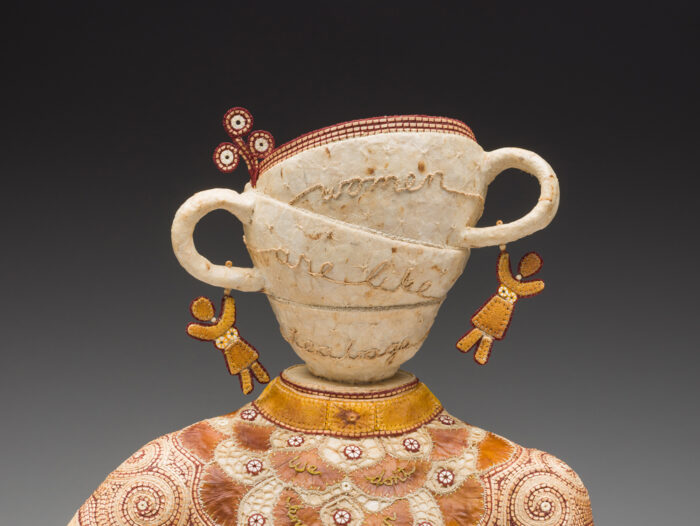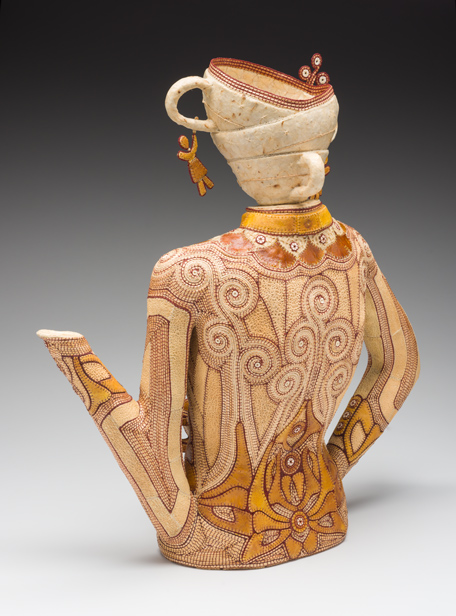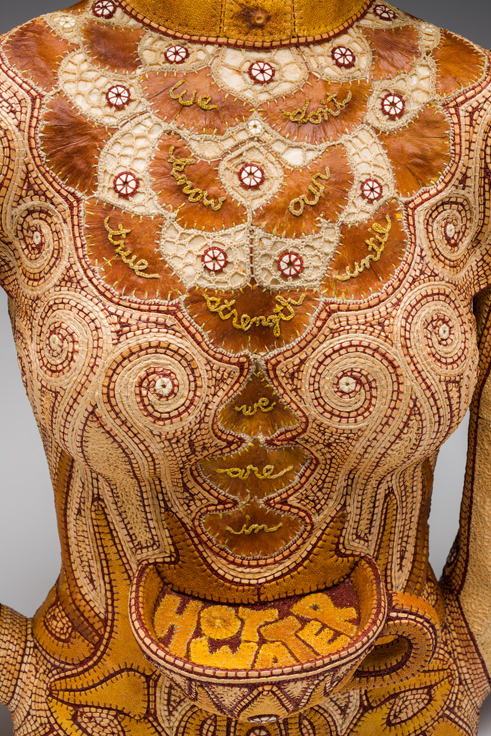Fiber artist Jan Hopkins (American, b. 1955) has garnered a great deal of attention for her intricate baskets, teapots, and torso sculptures that utilize organic alternative materials. Using items such as fruit peels, seed pods, and fish skins, she creates complex rich surfaces that are not only tactile, but extremely compelling. For Hopkins, each work tells a story. Frequently, these stories focus on honoring women, particularly strong iconic women. The Kamm Teapot Foundation has an example of one of these inspirational works in their collection.[i] Called Oh Eleanor, this mixed media sculpture is a standout.[ii] For this blog post we will take a closer look at this important piece and explore how Hopkins began working as a fiber artist.
Basketry Background
Before launching her artistic career, Hopkins worked as a property manager, handled the administrative side of her husband’s illustration business, and she had already started a family.[iii] However, her life forever changed while visiting the Heard Museum in Phoenix, Arizona.[iv] There, Hopkins discovered Native American basketry. “[She] was fascinated by the fact that the baskets were made of grasses, roots, and bark that were processed and refined to make beautiful utilitarian vessels. The moment [Hopkins] saw them, [she] felt [she] needed to find out how to make them. It was an immediate passion.”[v] In 1988 the Hopkins family moved to Washington State. There, she began taking classes at the Basketry School in Seattle and Hopkins enrolled in workshops to learn more about indigenous, traditional, and contemporary styles of basketry.[vi] She describes moving to the Northwest as “magical.”[vii] For Hopkins, “the lush environment and [her] obsession with basketry were the perfect combination to find [her] voice in fiber art.”[viii]
From her studies, Hopkins became more aware of the important role natural materials played in basketry. Unfortunately, the use of these natural materials were at times problematic because “harvesting was being restricted to guard against depletion.”[ix] Hopkins wondered, “Why aren’t we experimenting with the things in our environment? There is such an abundance of material…Everyone has an orange…”[x] Although she continued to make baskets, these questions took Hopkins’ work in a new direction. Using alternative organic materials such as dried fruit peels, she began working larger and in a much more sculptural manner. In a 2014 interview Hopkins said, “Experimenting and using materials that are thought of as mundane and unusable is an adventure I am addicted to…”[xi] Essentially, “it is why [she] continues to make art.”[xii]
In 1999 Hopkins entered her first national juried exhibition and by 2001 her work was on view in Chicago at SOFA (Sculpture Objects and Functional Art and Design exhibition).[xiii] Since that time, her art has been in high demand. Hopkins, who is often in the studio fourteen hours a day, says, “I think my whole career has been lucky, unexpected, and not planned…like I fell into it…like it’s too much. In fact, it is overwhelming at times.”[xiv]
Oh Eleanor
The Kamm Collection’s Oh Eleanor is part of Hopkins’ Women Icon Series in which she focuses on important figures who faced “strong adversity” such as Frida Kahlo, Gertrude Stein, and Helen Keller.[xv] Oh Eleanor is an homage to Eleanor Roosevelt, one of America’s most outspoken First Ladies. With each work in this series Hopkins “wrapped the design around the idea of [a] quote.”[xvi] For instance with Oh Eleanor, inspiration came from the quotation: “Women are like teabags. We don’t know our true strength until we are put in hot water.”[xvii] Hopkins felt these two sentences illustrated Eleanor Roosevelt’s “personality and her ability to speak clearly.”[xviii]
Oh Eleanor is “more whimsical than [her] previous pieces in this series…and intentionally a bit sassy.”[xix] Hopkins describes the work as “part human and part teapot.”[xx] The sculpture features a woman’s torso shaped like a teapot. Her crooked arms are positioned to resemble a handle and spout, three cups are stacked in place of her head (with dangling earrings in the shape of figures), and a cup protrudes from her stomach. Along the front of the form Hopkins has stitched Roosevelt’s inspirational teabag quote. The last words “hot water” are located inside the cup bulging from the torso’s stomach. Alternative organic materials played an integral role in the construction of Oh Eleanor. The traditional material cedar bark was combined with grapefruit and cantaloupe peels, hydrangea petals, ostrich shell beads, and lunaria seed pods. Also, Hopkins employed ginkgo leaves which she found to closely resemble teabags in appearance.
These items were molded and then meticulously hand stitched together with waxed linen thread creating rich surface patterns in shades of gold, tan, burgundy, and off white.[xxi] Hopkins wanted these patterns to mimic period dress styles popular during Roosevelt’s lifetime. The result is a striking arrangement that captures the essence of this time-honored quote.
Today Hopkins can be found in her Washington State studio continuing to push her work in different directions. In August of 2020 she was included in the exhibition Threads Through Time at the University of Central Arkansas’ Baum Gallery.[xxii] The two works on view were part of a new series. In this series Hopkins is focusing on the internment of Japanese Americans during World War II, an event that greatly impacted her family.
FURTHER READING/VIEWING:
Lee, Anne and E. Ashley Rooney. Artistry in Fiber: Sculpture (Vol. 2). Atglen, PA: Schiffer Publishing, Ltd., 2017.
Scott Jacklyn, Kristin Müller, and Tommy Simpson. Making Good: An Inspirational Guide to Being an Artist Craftsman. Atglen, PA: Schiffer Publishing, Ltd., 2017.
Notes:




